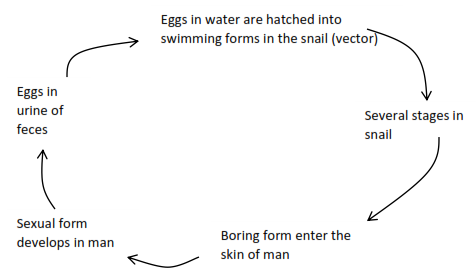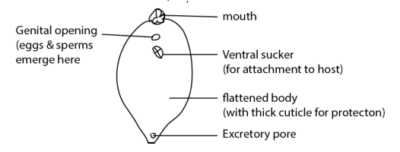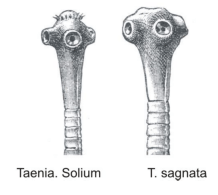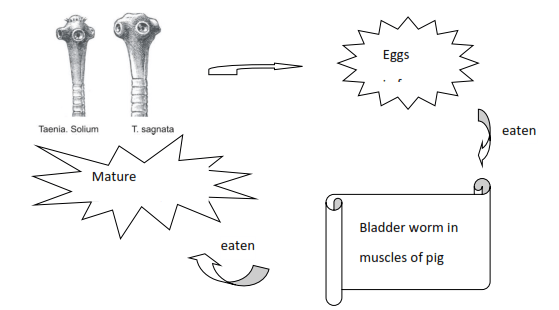
Phylum Platyhelminthes (Flatworms) (O and A-level)

Phylum Platyhelminthes (Flatworms)
Characteristics
- their bodies are flat with distinct heads.
- they are parasitic
- are hermaphrodite (have both sexes)
- They are triploblastic with a body wall composed of an outer epidermis and inner gastrodermis separated by a relatively undifferentiated region of mesoderm called mesenchyme.
They are subdivided into three classes
- Turbellaria: these are carnivorous flatworms found in flesh water, streams, and ponds. It remains underwater during day and comes out to feed at night e.g. planarian
A diagram of planaria showing external feature

- Trematoda; are generally endo or ectoparasites e.g.
- fasciola hepatica or liver fluke is a parasite found in the liver.
- Blood fluke causes bilharzia.
Life cycle of the blood fluke

External features of fasciola hepatica

Economic importance
Liver fluke causes liver diseases, large number block bile ducts.
Blood fluke causes bilharzia.
- Cestoda (tapeworms)
- they are endoparasites found in the alimentary canal of vertebrates.
- They are ribbon-like with distinct head or scolex and a series of segments or proglottis
- The proglottis contains both male and female reproductive systems.
- Lacks a digestive system
- Lacks any means of locomotion
They are two types
- Taenia saginata uses a cow as a secondary host.
- Taenia solium uses a pig as a secondary host

Life Cycle of a tapeworm

Harmful effects of tapeworms
- They are parasites
- They may block the intestine and cause constipation and other problems
- Lead to anemia
Control of the spread of tapeworms
- proper disposal of feces
- eat well-cooked food
- proper sanitation
- regular deworming with drugs
Dangers of the parasitic mode of life
- failure to find a host
- Failure to penetrate a host
- Failure to protect self from host defense mechanisms.
Adaptations of the tapeworm parasitic mode of life
- possesses suckers and hooks for attachment
- produces a lot of mucus that protects it from the host digestive enzyme
- produces a large number of eggs to increase the chance of finding a host
- has intermediate secondary host e.g. pig or cow.
- lack unnecessary organs to reduce energy demands.
- it’s hermaphrodite to increase the rate of egg production.
- it survives in low oxygen area by using anaerobic respiration
- has a resistant stage in the soil.
- it’s flat and long to increase the absorptive surface.
- can regenerate
How to control the spread of tapeworm
- proper disposal of feces
- Eat well-cooked food and water
- Regular deworming
Sponsored by The Science Foundation college +256 753 80 27 09
Compiled by Dr. Bbosa Science
CATEGORIES A-level Biology
TAGS Dr. Bbosa Science

This is so interesting, thanks for posting! Bags Wallet & Luggage
You have a real gift for storytelling. 500 ka redeem code
Access leading institutions via MBBS Admission Through Management/Nri Quota in Orissa.
Learn about admission trends at MBBS Cutoff Of Government Medical Colleges in Punjab.
Play your favorite games anytime with the Raja Luck App.
Keep an eye on your game history and deals through the 82 Lottery Login control panel.
Discover the latest innovations and trends in the electric vehicle industry with our EV News updates.
Release service applications smoothly with efficient Server Rental in Bengaluru.